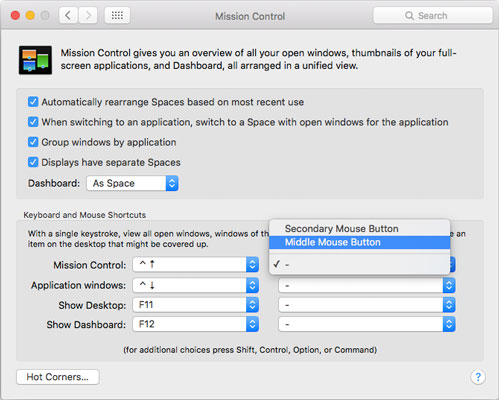
- #Mac mission control shortcut how to
- #Mac mission control shortcut mac os x
- #Mac mission control shortcut mac
- #Mac mission control shortcut windows
By default, macOS has a single desktop, which appears as a thumbnail in the Mission Control toolbar. The main Mission Control window displays all your open tabs, applications and windows, but towards the top of the screen you’ll also find all your desktops.
#Mac mission control shortcut mac
Depending on your model of Mac and how it’s setup, there’s several ways that you can access Mission Control: And now I won’t have a problem with Show Desktop, either.You access the multiple desktop feature via macOS’ Mission Control. The other two behaviors don’t interest me, as I’ve never had a problem with the keyboard shortcuts for Mission Control or Application Windows.

#Mac mission control shortcut windows
#Mac mission control shortcut mac os x
Which I learned about indirectly through this old Mac OS X Hint. The shell command it executes is /Applications/Mission\ Control.app/Contents/MacOS/Mission\ Control 1 The macro is triggered by F5, the only function key on both my iMac and MacBook Air that doesn’t have a feature assigned to and printed on it. I turned off that shortcut in System Preferences and built a Keyboard Maestro macro to do the job. Today, after running into the problem once again, I decided to take matters into my own hands. With luck, Yosemite will erase this annoyance and I won’t have to think about it again.Īs you have no doubt guessed by now, Yosemite didn’t erase the annoyance. Rereading that post, I see how innocent and naive I was back then: This problem started with Mavericks and occurred only on the iMac, never on my MacBook Air. It’s only after I get a beep when I hit F6 that I realize what I’ve done have to reboot a second time. Unfortunately, I reboot so infrequently that I almost never remember to uncheck the box ahead of time. If I uncheck the Show Desktop box in the Keyboard Shortcuts panel and then reboot, rechecking the box after the reboot will get the shortcut working again.

#Mac mission control shortcut how to
Through trial and error, I’ve learned how to solve the problem and, in some cases, how to prevent it from happening in the first place. Basically, whenever I rebooted my iMac, the keyboard shortcut stopped working, even though it was still checked in the Keyboard Shortcut system preference.

Way back in September of 2014, I wrote about a problem I was having with a keyboard shortcut to toggle Mission Control’s Show Desktop feature. Next post Previous post Keyboard Maestro beats System Preferences


 0 kommentar(er)
0 kommentar(er)
